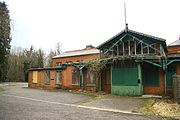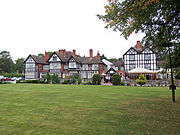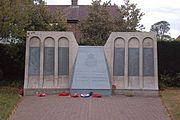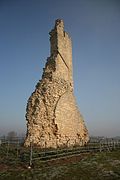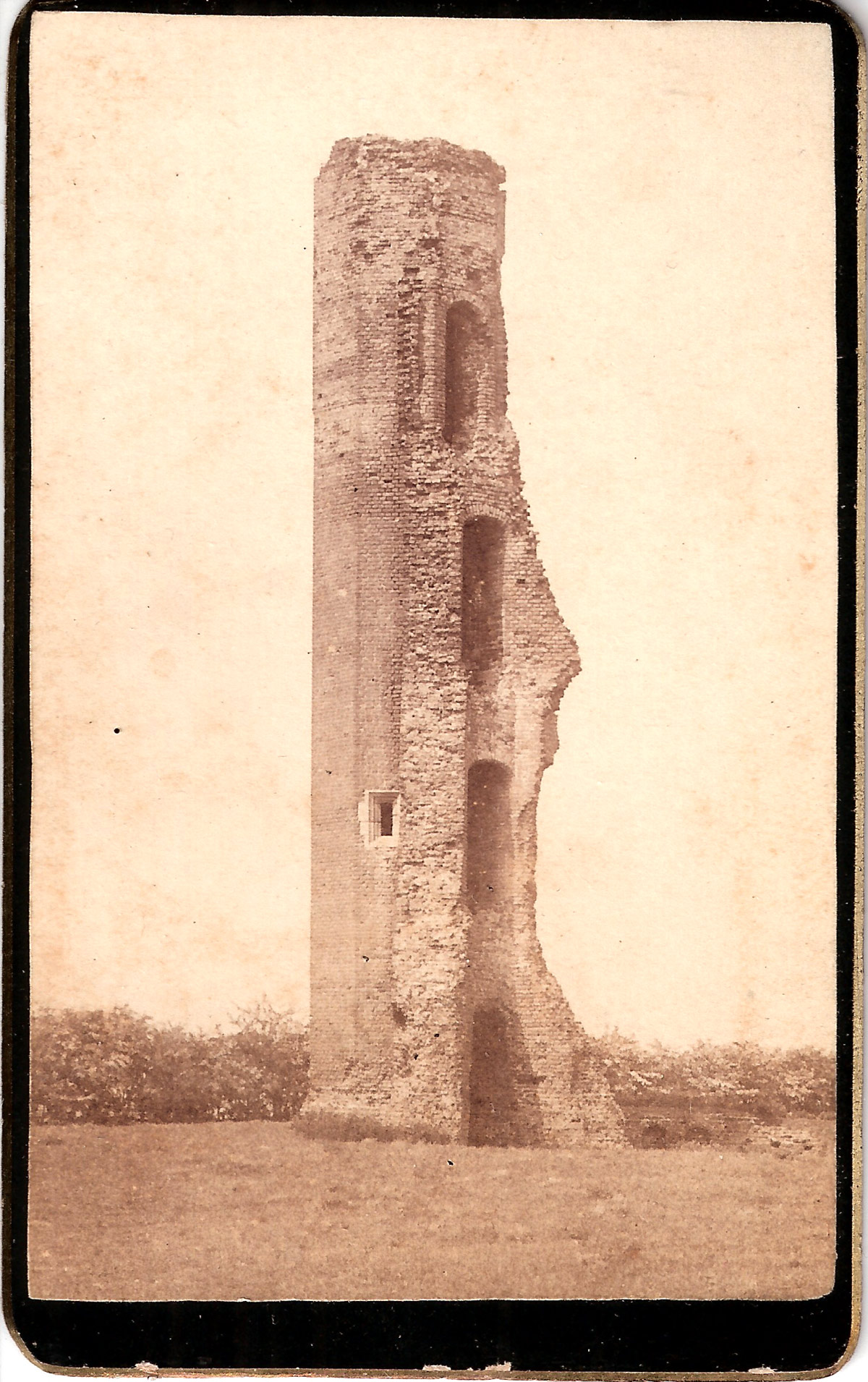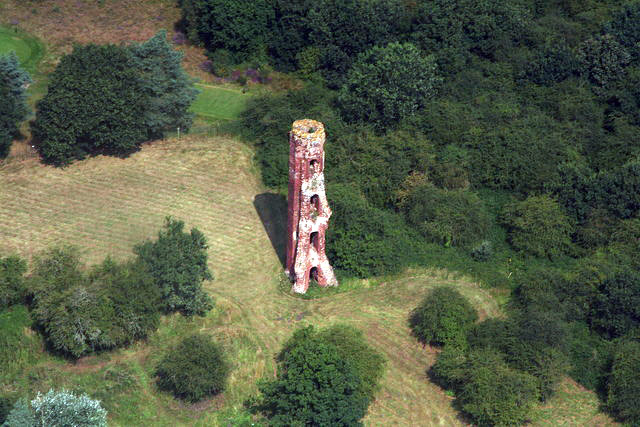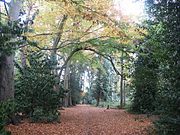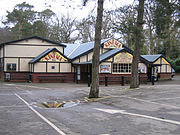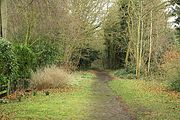Contact Beth Northrop
ejnorth123 AT juno.com
![]()
Woodhall Spa
|
Woodhall Spa is a civil parish and village in the East Lindsey district of Lincolnshire, England within a wooded area on the Southern edge of the Lincolnshire Wolds, about 6 miles (10 km) south-west of Horncastle and about 15 miles (24 km) east-south-east of Lincoln. It is noted for its mineral springs, cinema, and its World War II association with the RAF 617 Squadron. Twin Towns
HistoryThe development of Woodhall SpaWoodhall Spa came about by accident in 1811 after John Parkinson, of Old Bolingbroke made several attempts to find coal.[2] After spending several thousand pounds, and sinking a shaft over 1,000 feet deep, the enterprise was abandoned on account of the now rising spring.[3][4] The spring flows daily through soft spongy rock, at a depth of 520 feet.[5] About 1834, the then Lord of the Manor, Thomas Hotchkin, ascertained by analysis that the water was in fact valuable, being an iodine andbromine containing mineral spring.[6] He spent nearly £30,000 sinking the well and erecting the Spa Baths and the Victoria Hotel.[2][7] The Victoria Hotel burned down on Easter Day, 4 April 1920 when an electrical fault in the boiler room spread to the linen room above.[8] The Spa Baths finally closed when the well collapsed in 1983.[9] Other hotels sprang up due to Woodhall Spa's popularity and included: The Legacy Woodhall Spa Hotel, which opened in 1882 as the Eagle Lodge Hotel.[10] It was converted into a nursing home in the 1960s and reopened as a hotel in 1991.[11] The Golf Hotel was originally called Clevedon House and has been a school, a club, and a hotel of the same name.[12][13] Most of the Royal Hydro Hotel and Winter Gardens were destroyed by a parachute mine which fell on 17 August 1943, although part of it did survive and became the Mall Hotel[13][14] The Petwood Hotel is so called because it was originally built at the turn of the 20th century as a house for Lady Grace Weigall, who had it constructed in her favourite wood, her "pet wood". Lady Weigall turned her former home into a hotel in 1933.[13] The heyday of Woodhall Spa was recorded by a local photographer, John Wield and many of his photographs are displayed in the Woodhall Spa Cottage Museum, which was his home.[13][15] Much of the village's Victorian elegance remains, and since January 1991 it has been a designated conservation area.[16]
RailwaysMain article: Woodhall Spa railway station
In 1846 the Great Northern rail company purchased the land to build a 58 miles (93 km) rail link from Peterborough to Lincoln. Works commenced in 1847 and the line opened on 17 October 1848.[18] The Kirkstead Station, later to be renamed the Woodhall Junction, was one of seven between Lincoln and Boston. A branch of the line, to Horncastle, which included Woodhall Spa railway station, was opened on 11 August 1855.[18] The railways brought increasing popularity and an elegant spa town with hotels and guest houses on wide tree-lined avenues, largely designed by Richard Adolphus Came, grew up around the original facilities. He stated in his designs that none of the roads shall be 'streets' which is still true today and the roads built since have also been lined with various trees.[19] In 1886 the estate was purchased by a syndicate and extensive alterations and improvements were made.[3] The Victoria Hotel and the Spa Baths were greatly modified by the Syndicate,[19] a group of investors including Lord Alverstone, Lord Iddesleigh, and Edward Stanhope MP in 1887.[19] Woodhall and Woodhall Spa stations closed along with the rest of the Boston to Lincoln line in 1971 and demolition came soon after.[18] The Second World WarIn the Second World War Woodhall Spa's two main hotels, The Golf Hotel and The Petwood Hotel, were requisitioned for the RAF, and Pinewoods used to hide military equipment, especially on its northern perimeter. RAF Woodhall Spa airfield was built to the south of the village[20] in the parish of Tattershall Thorpe. It closed for operational purposes in 1964, although it is still owned by the Ministry of Defence and used mainly for jet engine testing.[citation needed] A memorial wall depicting the breaching of the German dams in Operation Chastise, otherwise known as the "Dam Busters" raid, stands at the crossroads in the centre of the village. It is dedicated to the memory of those from 617 Squadron who were lost during the night of 16–17 May 1943.[21] The memorial is the location of a local school choir photograph, published Lincolnshire Life magazine, which included a black Labrador dog; the photo-caption asks if this "mysterious" animal was Guy Gibson's dog, which was run over and killed shortly before Gibson departed to bomb German dams.[21] Kirkstead and Woodhall SpaMain article: Kirkstead
The more ancient parish of Kirkstead amalgamated with Woodhall Spa in the early 1980s thus formalising what was already a reality.[22] Kirkstead is the western side of Woodhall Spa between the village centre and the River Witham. It has its origins inKirkstead Abbey, of the Cistercian order, founded in 1139 by Hugh Brito, Lord of Tattershall It was around this abbey that the little hamlet of Kirkstead grew.[23] The railways spelled the end of Kirkstead's isolation and eventually of Kirkstead itself, as Woodhall Spa's increasing popularity led it to expand outwards into Kirkstead parish until it reached the banks of the River Witham.[citation needed] Historic estatesThe Manor HouseThe Manor House in Woodhall Spa appears to have been built in the 18th century.[24] In the first half of the 19th century it was known as Woodhall Lodge or simply The Lodge. It was occupied by several generations of the Hotchkin family, originally from Rutland. Thomas Hotchkin (1774–1843) died there in June 1843 (Stamford Mercury, 9 June 1843). In 1861 it was in the possession of his grandson Thomas John Stafford Hotchkin.[25] By the 1880s it had become known as The Manor House, and Thomas John Stafford Hotchkin lived there until he died in 1891. His widow Mary moved into a purpose-built Dower House in 1906 enabling son Stafford Vere Hotchkin and his new wife to move into the Manor House. Stafford Hotchkin's son Neil sold the property in 1965 to the National Farmers Union, who sold it in 1992.[26]
The Tower-on-the-MoorThe Tower-on-the-Moor, a four story high red brick built tower, is the stair turret of what is believed to have been a hunting lodge built in the mid 15th century for Ralph de Cromwell, 3rd Baron Cromwell whose fortified house, Tattershall Castle, was located 4 miles (6 km) to the south.[27] It is a Grade II Listed Building,[27] and a scheduled Ancient Monument.[28] It is known[by whom?] that the tower was partly demolished in the latter part of the 15th century to provide brick for repairs to Tattershall Castle. One of the older local roads in Woodhall Spa, Tor-O-Moor Road is named after the tower.[citation needed] RecreationThe Pinewoods and Kinema in the WoodsThe Pinewoods, is a 7.8 ha woodland at the centre of the village, owned by the Woodland Trust.[29] It is made up of mature Oak, Scots Pine, Beech and Birch. Originally scrub land, later becoming part of the grounds of the Victoria Hotel, it attracts visitors, particularly in the spring and autumn.[29] Near to the former airfield is another wood, Ostlers Plantation, which is the remaining part of several hundred acres planted by John Parkinson.[13] Main article: The Kinema in the Woods
The unique Kinema in the Woods, situated at the centre of the Pinewoods, is one of the treasures of Woodhall Spa. It is located next to the now derelict Spa Baths and opposite the site of the former Victoria Hotel. Housed in a converted cricket pavilion, when it opened in 1922 it was one of the first cinemas in Britain. It is one of the few cinemas in the country to still employ back projection[30][31] and also offers regular entertainment on an original Compton Captain Organ. Jubilee ParkJubilee Park, opened in 1937, lies adjacent to the Pinewoods and includes Jubilee Park Swimming Pool a facility that is fairly busy in summer, a heated outdoor swimming pool. The park also offers tennis courts, a bowling green, children's playground, croquet and a cricket ground,[13]which is home to Woodhall Spa Cricket Club.[32] On 22 December 2010, BBC Radio 4 broadcast the half-hour long Australian Wanted in Woodhall Spa, presented by Chris Ledgard and detailed overseas players playing for English amateur cricket clubs.[33] In December 2010 East Lindsey Council sold Jubilee Park to the Woodhall Spa residents for one pound.[34] It is currently undergoing renovations.[35] Jubilee Park is next to a caravan park of the same name.[36] National Golf CentreThe first nine hole golf course was opened in Woodhall Spa in 1890, but only survived until 1895 when the land that the course was built on was required for building.[19] A new site was found and another nine hole golf course was laid out, but by 1902 it became clear that the golf course would have to find another new home as the land was required for the expansion of the spa town again.[19] Local landowner, Stafford Vere Hotchkin, offered a sandy tract of land off the Horncastle Road for the building of an 18 hole course. The course was designed by Harry Vardon and was formally opened for play on 24 April 1905. It was remodelled in 1911 by Harry Colt, and again by Hotchkin himself in the 1920s.[37] Womersley House was built by the Hotchkin family who were instrumental in the development of the adjoining Hotchkin Golf Course (now the headquarters of the English Golf Union).[38] The English Golf Union bought the course in 1995 in order to set up a National Golf Centre.[37][39] A second course, "The Bracken", opened for play in 1998 alongside the original course, now named "the Hotchkin".[39] The St Andrews Trophy was held at the golf course in 1996.[citation needed] Most recently, it was voted 20th best course in the world by Today's Golfer magazine in 2010.[40] FootpathsThe Viking WayThe Viking Way is a 147 miles (237 km) long-distance footpath which passes through Woodhall Spa.[41] Spa TrailThe Spa Trail runs for 3.3 miles (5.3 km) along the Viking Way and the old Horncastle Railway between Sandy Lane near Woodhall Spa and Thornton Lodge near Horncastle.[41][42]With the Viking Way it forms a continuous traffic-free footpath between Woodhall Spa and Horncastle. Water Rail WayThe Water Rail Way is a 25 miles (40 km) long part of the National Cycle Network that runs from Boston to Lincoln following as closely as possible the banks of the River Witham. Between Woodhall Spa and Lincoln it consists of a tarmaced path that runs along the route of the former railway line from Boston to Lincoln. It was built and financed by Sustrans organisation and was finally completed and opened in November 2008. It is open to all forms of non-motorised transport, forming part of NCN Route 1. Named primarily after its route and former use, the path is also so named due to the rare Water Rail bird.[43] ChurchesSaint Peters church was built in 1893[44] although it was not until 1915 that it was legally designated the parish church.[44] Until then the little church of Saint Andrews, built in 1846,[45] was the parish church, but was too small for the rapidly growing town.[44] Woodhall Spa is part of a group of six Anglican parishes comprising: Woodhall Spa and Kirkstead, Stixwould, Horsington, Langton with Old Woodhall, and Bucknall with Tupholme.[46] The Church of Our Lady and Saint Peter,[46] built in 1893,[45] is Woodhall Spa's Roman Catholic church. EducationThere are two schools within Woodhall Spa which are St Hugh's,[47] a preparatory boarding school on Cromwell Avenue and St Andrew's C of E Primary School on King Edward Crescent. Secondary schools are outside of Woodhall and include Queen Elizabeth's Grammar School and Banovallum School in Horncastle and Gartree Community School in Tattershall. GeographyWoodhall Spa lies at the south western edge of the Central Lincolnshire Vale, between the Rivers Witham and Bain. The village is largely flat rising gently towards the east and is surrounded towards the north and east by a mixture of ancient and planted woodland. To the south-west can be found many abandoned and in use sand and gravel excavation pits, many of which are now protected nature reserves. To the north-west, south and immediately west can be found arable farmland, with the River Witham found one mile to the west of the village centre and arable fenland beyond that. Much of the land on which the village is built was once extensive heathland with a light fluvial sandy soil.[48] The civil parish of Woodhall Spa borders the civil parishes of Tattershall Thorpe, Timberland, Martin, Stixwould and Woodhall, Roughton, and Kirkby on Bain.
|
|||||||||||||||||||||||||||||||||||||||||||||||||||||||||||
